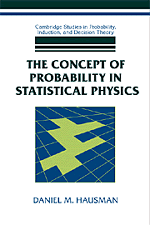Book contents
- Frontmatter
- Contents
- Introduction
- Chapter 1 The Neo-Laplacian Approach to Statistical Mechanics
- Chapter 2 Subjectivism and the Ergodic Approach
- Chapter 3 The Haar Measure
- Chapter 4 Measure and Topology in Statistical Mechanics
- Chapter 5 Three Solutions
- Appendix I Mathematical Preliminaries
- Appendix II On the Foundations of Probability
- Appendix III Probability in Nonequilibrium Statistical Mechanics
- Author Index
- Subject Index
Chapter 3 - The Haar Measure
Published online by Cambridge University Press: 12 November 2009
- Frontmatter
- Contents
- Introduction
- Chapter 1 The Neo-Laplacian Approach to Statistical Mechanics
- Chapter 2 Subjectivism and the Ergodic Approach
- Chapter 3 The Haar Measure
- Chapter 4 Measure and Topology in Statistical Mechanics
- Chapter 5 Three Solutions
- Appendix I Mathematical Preliminaries
- Appendix II On the Foundations of Probability
- Appendix III Probability in Nonequilibrium Statistical Mechanics
- Author Index
- Subject Index
Summary
GROUP-INVARIANT MEASURES
In 1933, Alfred Haar wrote a paper, entitled “The Concept of Measure in the Theory of Continuous Groups,” whose main objective was to construct a measure invariant to the action of a topological group. The importance of the paper must have been noticed immediately, and further studies followed shortly on its heels. Von Neumann proved the uniqueness of this measure in 1934. In 1937, Stefen Banach wrote an appendix about the Haar measure for a textbook about integration theory, and in 1940 both Weil and Cartan offered new uniqueness proofs. What is interesting and important about Haar's construction is that it leads (in most important cases) to a measure that is different from the Lebesgue measure by only a factor of proportionality. However, because the Haar measure is more general and abstract, it can illuminate and even justify the choice of the Lebesgue measure as the natural measure. In particular, the construction makes it easier to explain why we use the Lebesgue measure as a probability measure when it is defined as a volume measure.
The Haar measure is hardly unknown to mathematicians. In fact, for many mathematicians the Haar construction constitutes the foundation of their views on probabilities. It contains existence and uniqueness proofs in a fairly general setting, and it coincides with our pretheoretical notions of how probability measures ought to behave. However, the importance of the Haar measure is not due solely to its mathematical character.
- Type
- Chapter
- Information
- The Concept of Probability in Statistical Physics , pp. 134 - 150Publisher: Cambridge University PressPrint publication year: 1999

